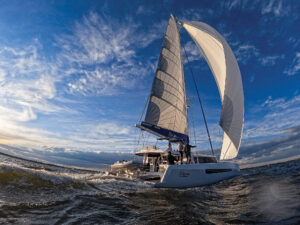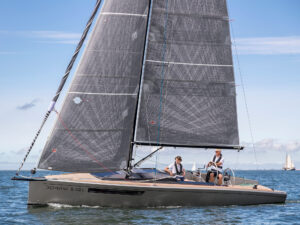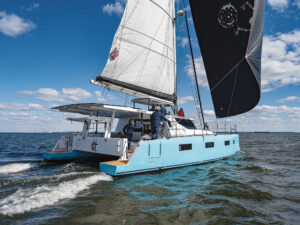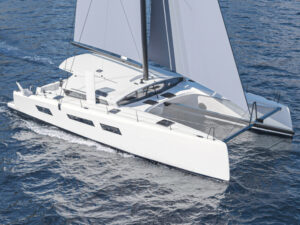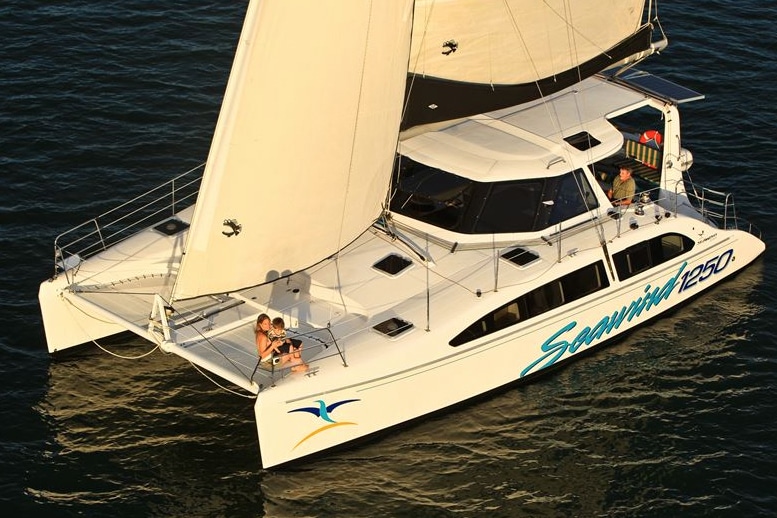
Introduced to the United States in 2007, the Seawind 1160 quickly won _ Cruising World_’s Boat of the Year honors for Best Catamaran. The new 1250 hasn’t yet made it to the States, but when it does, it will arrive with many of the same well-thought-out design details, but in a 41-foot package that’s 3 feet longer and about a foot wider than its predecessor. The result is a boat with a bit more powerful rig, higher water clearance, a little more speed through the water, and a roomier living space that comes with a revamped bimini over the aft deck and locates helm seats and two steering stations to either side of the cockpit (see the complete photo gallery here).
What remains unchanged is an open interior that flows aft to the cockpit thanks to a clever tri-fold door that folds up and stores under the bimini, a galley-up or a galley-down design (the latter of which creates immense space in the saloon but still lets the chef remain a part of the action), and a three- or four-cabin layout that you choose depending on your sailing plans.
Seawind is Australia’s largest catamaran builder, and its owner, Richard Ward, builds boats to suit local conditions that can be quite boisterous at times, such as when a southerly buster delivers 40-knot gusts and the consequent impressive waves. Luckily, we avoided those in our two-day test sail through the Whitsundays, but still we found conditions varying enough to give a good inkling of how the 1250 holds up in a squall and keeps moving when the breeze drops to near nothing. The boat is intended by the builder to be a true bluewater cruiser.
With the boat under power, Seawind’s director of sales, Brent Vaughan, used the twin 29-horsepower Yanmar diesels and saildrives to deftly move us off a tight dock and out into the waters off Hamilton Island. With sails soon set—the main was spun up effortlessly from its boom pouch using a self-tending electric winch near the port wheel—we sailed along quite comfortably at 7 knots or better in a breeze that hovered in the mid teens. When a front passed through later in the afternoon and sent gusts into the 20s, we picked up a knot or better of boat speed, but the ride remained smooth as could be. The little tacking we did do was simplified thanks to the self-tending jib set on a roller furler. Twin wheels mean you can steer from where the visibility’s the best, and the location of the wheels allows you to sit outboard on either hull, where you can enjoy both the breeze and see the telltales. Windows forward of the wheels can be removed, which means you can also stay under the bimini and out of the weather but still have good sight lines forward.
Evening found us anchored in an open cove in which swells rounding the point had nearby monohulls rolling, though we sat flat and calm and took advantage of the Aussie-style barbecue that’s incorporated into the stern rail and seats that span the transom.
Our boat was a four-cabin model from Charter Yachts Australia. The two aft cabins and an athwartship forward double to port all shared a head and shower amidships in the port hull. The galley, with natural light pouring in through the hull ports, was amidships to starboard, with a fore-and-aft double and en suite head and shower forward.
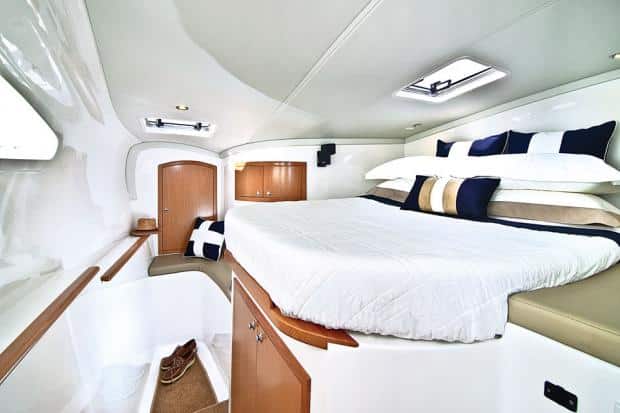
In the saloon, a versatile—and nicely finished—wood table can be rotated to accommodate crews of various sizes, or it can be dropped down to provide a huge lounging area, double berth, or comfortable place to spend a night watch. Large, opening windows provide fresh air when the boat’s anchored. A daybed just to port of the table is a comfortable place to escape the sun.
Seawinds are built in a new plant in Wollongong. Hulls are sandwiches fashioned from resin-infused glass and Divinycell, which means that weight and strength can be closely monitored. Divinycell is also used in the deck and other components for weight savings. The finish throughout the boat we sailed was clean and well crafted. And the attention to detail, both below and on deck, was well evident. Few builders these days offer triple lifelines, but with Seawind, safety is clearly paramount.
Seawinds aren’t the least-expensive catamarans on the market—the French will likely stake this claim for the time being—but still, the company is hedging for the future. It recently bought Corsair, and Ward has outlined his plans to begin taking advantage of certain cost savings by manufacturing at least some Seawind components at the Corsair facility in Vietnam. In the meantime, Seawinds dominate Australian waters, a good proving ground for bluewater cats that can roam the globe.

